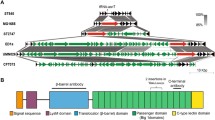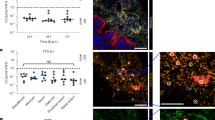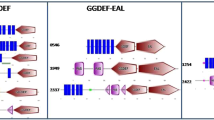Abstract
The autoinducer-2 signal (AI-2) produced by several Gram-positive and Gram-negative bacteria mediates interspecies communication. In this study we were able to identify an orthologue of luxS, required for the synthesis of AI-2 signals, in Streptococcus anginosus. Comparative analyses revealed conserved sequences in the predicted S. anginosus LuxS. Expression of luxS was highest during early exponential growth phase. Compared to other oral streptococci, conditioned media from growth of members of the anginosus group were the most efficient in inducing bioluminescence in Vibrio harveyi, indicative of AI-2 signalling. Disruption of luxS in S. anginosus resulted in a mutant deficient in biofilm formation, whereas no effect on planktonic growth rate was observed under various growth conditions. S. anginosus is part of the human flora found in biofilms of the oral cavity, as well as of the upper respiratory, gastrointestinal and urogenital tracts. Such habitats harbour large varieties of bacterial species, among which cell–cell communication may␣play an important role. S. anginosus has also been associated with purulent infections and cancer in the upper digestive tract. Knowledge about the molecular mechanisms involved in S.␣anginosus communication is important for understanding its commensalism and its pathogenic transition.
Similar content being viewed by others
References
Babb K, von Lackum K, Wattier RL, Riley SP, Stevenson B (2005) Synthesis of autoinducer 2 by the lyme disease spirochete, Borrelia burgdorferi. J Bacteriol 187:3079–3087
Balestrino D, Haagensen JA, Rich C, Forestier C (2005) Characterization of type 2 quorum sensing in Klebsiella pneumoniae and relationship with biofilm formation. J Bacteriol 187:2870–2880
Barletta RG, Michalek SM, Curtiss R 3rd (1988) Analysis of the virulence of Streptococcus mutans serotype c gtfa mutants in the rat model system. Infect Immun 56:322–330
Bassler BL, Greenberg EP, Stevens AM (1997) Cross-species␣induction of luminescence in the quorum-sensing bacterium Vibrio harveyi. J Bacteriol 179: 4043–4045
Beeston AL, Surette MG (2002) pfs-Dependent regulation of autoinducer 2 production in Salmonella enterica serovar typhimurium. J Bacteriol 184:3450–3456
Berry AM, Lock RA, Hansman D, Paton JC (1989) Contribution of autolysin to virulence of Streptococcus pneumoniae. Infect Immun 57:2324–2330
Blehert DS, Palmer RJ Jr, Xavier JB, Almeida JS, Kolenbrander PE (2003) Autoinducer 2 production by Streptococcus gordoniidl1 and the biofilm phenotype of a luxSmutant are influenced by nutritional conditions. J Bacteriol 185:4851–4860
Burgess NA et al (2002) LuxS-dependent quorum sensing in Porphyromonas gingivalis modulates protease and haemagglutinin activities but is not essential for virulence. Microbiology 148:763–772
Chen X et al (2002) Structural identification of a bacterial quorum-sensing signal containing boron. Nature 415:545–549
Chung WO et al (2001) Signaling system in Porphyromonas gingivalis based on a LuxS protein. J Bacteriol 183:3903–3909
Cole SP, Harwood J, Lee R, She R, Guiney DG (2004) Characterization of monospecies biofilm formation by Helicobacter pylori. J Bacteriol 186:3124–3132
Federle MJ, Bassler BL (2003) Interspecies communication in bacteria. J Clin Invest 112:1291–1299
Fong KP, Chung WO, Lamont RJ, Demuth DR (2001) Intra- and interspecies regulation of gene expression by Actinobacillus actinomycetemcomitans LuxS. Infect Immun 69:7625–7634
Fong KP, Gao L, Demuth DR (2003) LuxS and arcbcontrol aerobic growth of Actinobacillus actinomycetemcomitans under iron limitation. Infect Immun 71:298–308
Forsyth MH, Cover TL (2000) Intercellular communication in Helicobacter pylori: LuxS is essential for the production of an extracellular signaling molecule. Infect Immun 68:3193–3199
Frias J, Olle E, Alsina M (2001) Periodontal pathogens produce quorum sensing signal molecules. Infect Immun 69:3431–3434
Gilmore KS, Russell RR, Ferretti JJ (1990) Analysis of the Streptococcus downei gtfs gene, which specifies a glucosyltransferase that synthesizes soluble glucans. Infect Immun 58:2452–2458
Greenberg EP, Ulitzur S, Hastings JW (1979) Induction of luciferase synthesis in Beneckea harveyi. Arch Microbiol 120:87–91
Hall-Stoodley L, Costerton JW, Stoodley P (2004) Bacterial biofilms: from the natural environment to infectious diseases. Nat Rev Microbiol 2:95–108
Hamada K et al (2003) Oxyanion hole-stabilized stereospecific isomerization in ribose-5-phosphate isomerase (rpi). J Biol Chem 278:49183–49190
Hilgers MT, Ludwig ML (2001) Crystal structure of the quorum-sensing protein LuxS reveals a catalytic metal site. Proc Natl Acad Sci USA 98:11169–11174
Håvarstein LS, Hakenbeck R, Gaustad P (1997) Natural competence in the genus streptococcus: evidence that streptococci can change pherotype by interspecies recombinational exchanges. J Bacteriol 179:6589–6594
Joyce EA, Bassler BL, Wright A (2000) Evidence for a signaling system in Helicobacter pylori: detection of a luxS-encoded autoinducer. J Bacteriol 182:3638–3643
Lee MS, Seok C, Morrison DA (1998) Insertion-duplication mutagenesis in Streptococcus pneumoniae: targeting fragment length is a critical parameter in use as a random insertion tool. Appl Environ Microbiol 64:4796–4802
Lewis HA et al (2001) A structural genomics approach to the study of quorum sensing: crystal structures of three LuxS orthologs. Structure (Camb) 9:527–537
Livak KJ, Schmittgen TD (2001) Analysis of relative gene expression data using real-time quantitative pcr and the 2(-delta deltac(t)) method. Methods 25:402–408
Lyon WR, Madden JC, Levin JC, Stein JL, Caparon MG (2001) Mutation of luxS affects growth and virulence factor expression in Streptococcus pyogenes. Mol Microbiol 42:145–157
Mah TF, O’Toole GA (2001) Mechanisms of biofilm resistance to antimicrobial agents. Trends Microbiol 9:34–39
McNab R et al (2003) LuxS-based signaling in Streptococcus gordonii: autoinducer 2 controls carbohydrate metabolism and biofilm formation with Porphyromonas gingivalis. J Bacteriol 185:274–284
Merritt J, Qi F, Goodman SD, Anderson MH, Shi W (2003) Mutation of luxS affects biofilm formation in Streptococcus mutans. Infect Immun 71:1972–1979
Miller MB, Bassler BL (2001) Quorum sensing in bacteria. Annu Rev Microbiol 55:165–199
Miller ST et al (2004) Salmonella typhimurium recognizes a chemically distinct form of the bacterial quorum-sensing signal AI-2. Mol Cell 15:677–687
Morrison DA, Trombe MC, Hayden MK, Waszak GA, Chen JD (1984) Isolation of transformation-deficient Streptococcus pneumoniae mutants defective in control of competence, using insertion-duplication mutagenesis with the erythromycin resistance determinant of pAMß1. J Bacteriol 159:870–876
O’Toole GA et al (1999) Genetic approaches to study of biofilms. Methods Enzymol 310:91–109
Petersen FC et al (2001) Expression and functional properties of the Streptococcus intermedius surface protein antigen I/II. Infect Immun 69:4647–4653
Petersen FC, Pecharki D, Scheie AA (2004) Biofilm mode of growth of Streptococcus intermedius favored by a competence-stimulating signaling peptide. J Bacteriol 186:6327–6331
Petersen FC, Scheie AA (2000) Genetic transformation in Streptococcus mutans requires a peptide secretion-like apparatus. Oral Microbiol Immunol 15:329–334
Piscitelli SC, Shwed J, Schreckenberger P, Danziger LH (1992) Streptococcus millerigroup: renewed interest in an elusive pathogen. Eur J Clin Microbiol Infect Dis 11:491–498
Prouty AM, Schwesinger WH, Gunn JS (2002) Biofilm formation and interaction with the surfaces of gallstones by Salmonella spp. Infect Immun 70:2640–2649
Rice SA, McDougald D, Kumar N, Kjelleberg S (2005) The use of quorum-sensing blockers as therapeutic agents for the control of biofilm-associated infections. Curr Opin Invest Drugs 6:178–184
Ruzheinikov SN et al (2001) The 12 Å structure of a novel quorum-sensing protein, Bacillus subtilis luxS. J Mol Biol 313:111–122
Sasaki M et al (2005) Streptococcus anginosusinfection in oral cancer and its infection route. Oral Dis 11:151–156
Shiga K et al (2001) Presence of streptococcus infection in extra-oropharyngeal head and neck squamous cell carcinoma and its implication in carcinogenesis. Oncol Rep 8:245–248
Stroeher UH, Paton AW, Ogunniyi AD, Paton JC (2003) Mutation of luxS of Streptococcus pneumoniae affects virulence in a mouse model. Infect Immun 71:3206–3212
Suntharalingam P, Cvitkovitch DG (2005) Quorum sensing in streptococcal biofilm formation. Trends Microbiol 13:3–6
Surette MG, Bassler BL (1998) Quorum sensing in Escherichia coli and Salmonella typhimurium. Proc Natl Acad Sci USA 95:7046–7050
Surette MG, Miller MB, Bassler BL (1999) Quorum sensing in Escherichia coli, Salmonella typhimurium, and Vibrio harveyi: a new family of genes responsible for autoinducer production. Proc Natl Acad Sci USA 96:1639–1644
Tao L, LeBlanc DJ, Ferretti JJ (1992) Novel streptococcal-integration shuttle vectors for gene cloning and inactivation. Gene 120:105–110
Tao L, MacAlister TJ, Tanzer JM (1993) Transformation efficiency of ems-induced mutants of Streptococcus mutans of altered cell shape. J Dent Res 72:1032–1039
Tateda M et al (2000) Streptococcus anginosus in head and neck squamous cell carcinoma: implication in carcinogenesis. Int J Mol Med 6:699–703
Vendeville A, Winzer K, Heurlier K, Tang CM, Hardie KR (2005) Making ‘sense’ of metabolism: Autoinducer-2, luxS and pathogenic bacteria. Nat Rev Microbiol 3:383–396
Wen ZT, Burne RA (2004) LuxS-mediated signaling in Streptococcus mutans is involved in regulation of acid and oxidative stress tolerance and biofilm formation. J␣Bacteriol 186:2682–2691
Whiley RA, Beighton D (1998) Current classification of the oral streptococci. Oral Microbiol Immunol 13:195–216
Whiley RA, Beighton D, Winstanley TG, Fraser HY, Hardie JM (1992) Streptococcus intermedius, Streptococcus constellatus, and Streptococcus anginosus (the Streptococcus millerigroup): association with different body sites and clinical infections. J Clin Microbiol 30:243–244
Xavier KB, Bassler BL (2003) LuxS quorum sensing: more than just a numbers game. Curr Opin Microbiol 6:191–197
Xavier KB, Bassler BL (2005) Regulation of uptake and processing of the quorum-sensing autoinducer AI-2 in Escherichia coli. J Bacteriol 187:238–248
Yoshida A, Ansai T, Takehara T, Kuramitsu HK (2005) LuxS-based signaling affects Streptococcus mutans biofilm formation. Appl Environ Microbiol 71:2372–2380
Yuan L, Hillman JD, Progulske-Fox A (2005) Microarray analysis of quorum-sensing-regulated genes in Porphyromonas gingivalis. Infect Immun 73:4146–4154
Zhu J et al (2003) S-ribosylhomocysteinase (LuxS) is a mononuclear iron protein. Biochemistry 42:4717–4726
Acknowledgments
We thank Steinar Stølen for performing the scanning electron microscopic images.
This study was supported by a postdoctoral fellowship from The Norwegian Research Council.
Author information
Authors and Affiliations
Corresponding author
Rights and permissions
About this article
Cite this article
Petersen, F.C., Ahmed, N.A.A.M., Naemi, A. et al. LuxS-mediated signalling in Streptococcus anginosus and its role in biofilm formation. Antonie Van Leeuwenhoek 90, 109–121 (2006). https://doi.org/10.1007/s10482-006-9065-y
Received:
Accepted:
Published:
Issue Date:
DOI: https://doi.org/10.1007/s10482-006-9065-y




